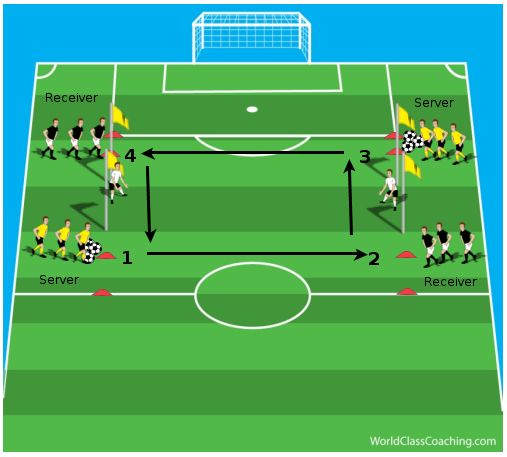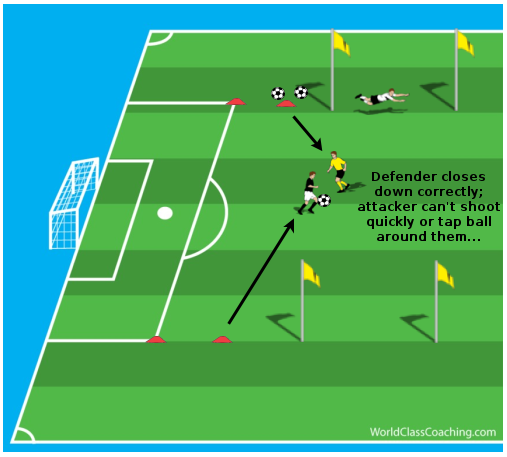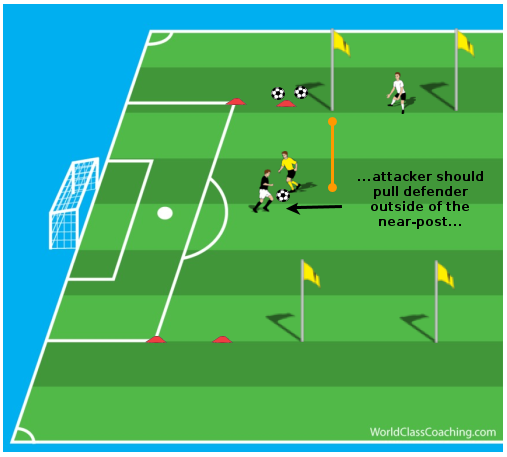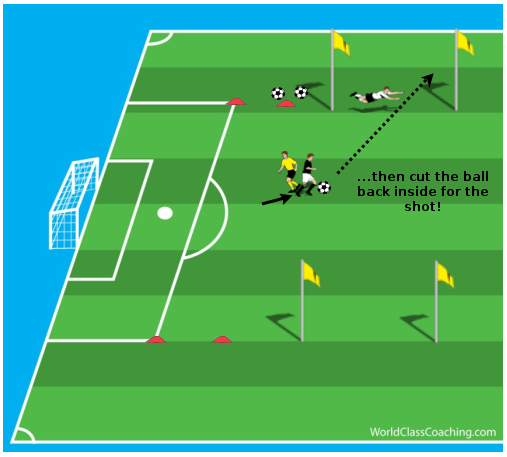By Keith Scarlett
This activity works on technical and tactical aspects of finishing, passing, attacking in a 1v1 situation and goalkeeping.
Set-up:
Field length is 44 yards (length of the penalty area). Width is from the edge/corner of the penalty area to the midfield line. Two flags should be placed in the middle of each end line to be used as goals. 4 additional cones should be placed equidistant from each corner-flag (goal-post) and each corner cone on the end lines; per the diagram.
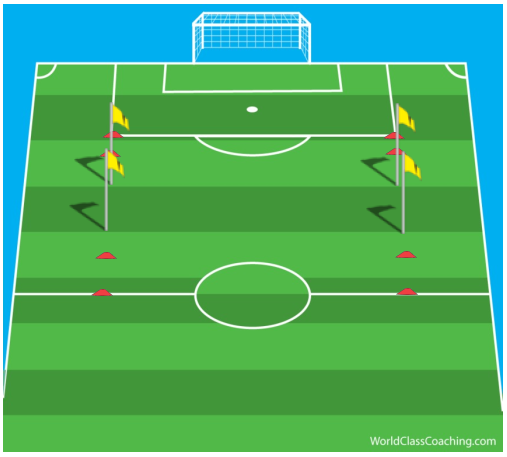
Each goal should have a goalkeeper in it whom is playing full-out and the balls should be split into two groups and placed opposite each other at a diagonal on each end-line; per the diagram.
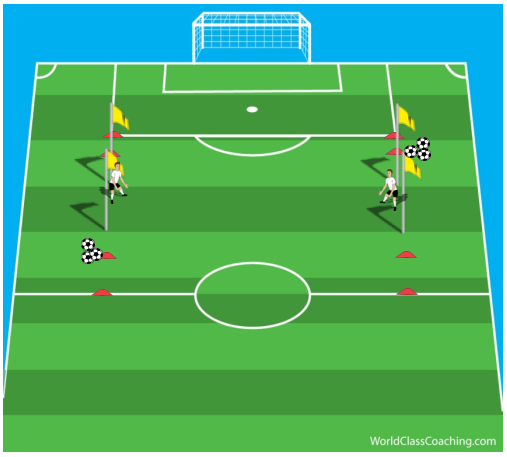
The players break into four separate groups and each group goes to one of the four cones one the end lines.
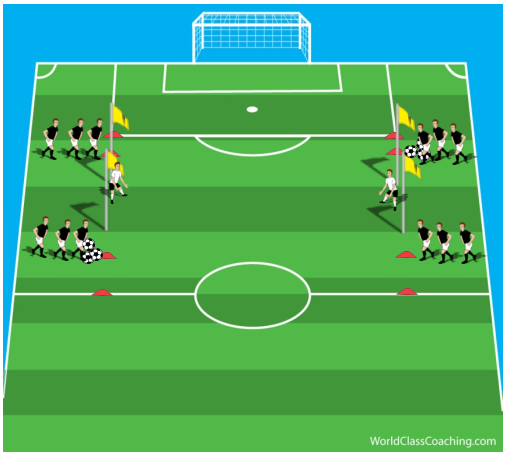
This is an ever-evolving activity; fast-paced “flowing” activity that will seem chaotic to those looking in from the outside, but will be quite organized to the players involved.
Here’s how it works:
The first player in each line is going to face the first player in the line directly opposite them on the other end-line in a 1v1 battle to goal. The player in the line who has the ball will serve the ball the length of the field to the first player in the opposite line (the line on the other end-line who does not have the balls) who should be checking forward to receive the ball in preparation of attacking the server 1v1 in an attempt to break them for a chance on goal. The server becomes the defender and is attempting to deny the attacker (receiver) a clean look at the goal. The defender should be playing full-out and should tackle and/or blow-up the play if the opportunity arises.
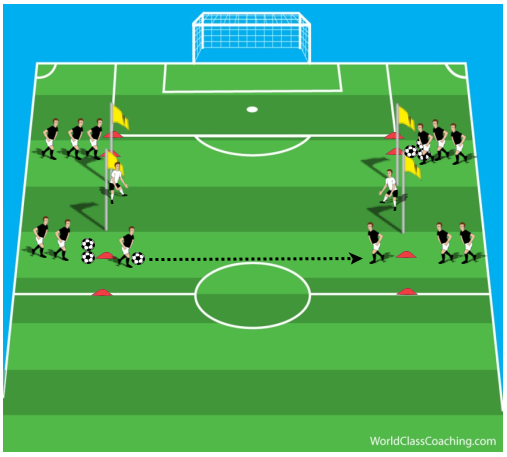
While this is happening on one side, it is also occurring on the other side simultaneously.
The goal which each attacker (receiver) is attacking and each defender (server) is defending) is the goal which is located on the same end line that the ball began on (the end line the ball was served from).
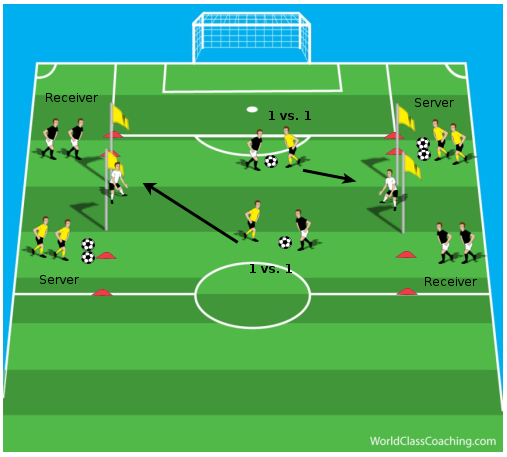
Players should rotate as follows: Server (1) to opposite end-line receiver (2) to same end line server (3) to opposite end line receiver (4). This would be a counter-clockwise rotation as seen in the diagram below.
- The attacker needs to work at taking their shot from inside the sticks (goalposts).
- The attacker’s first-touch is of the utmost importance. It needs to be towards the near-post, close enough that it does not carry to the defender, but still far enough away that it allows the attacker to run onto it and strike it one-time with their next touch if it is on.
- The attacker should set-up their final touch (shooting-touch) at a 45 degree angle.
There are three options an attacker will face when in these 1 vs. 1 situations:
1. The Defender will close down too slowly. When this occurs, the attacker should simply just take the shot!
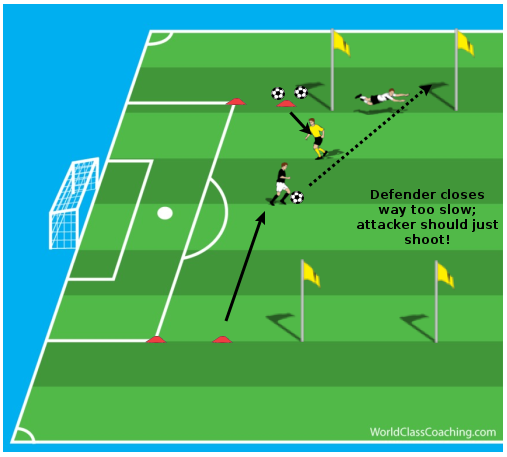
2. The Defender will close down too quickly. When this occurs, the attacker should simply “tap” the ball by the defender, allow the defender’s momentum to carry them past and then take the shot! It is important that when the attacker does this that they set the ball-up at a 45 degree angle so they are able to quickly get the shot off.
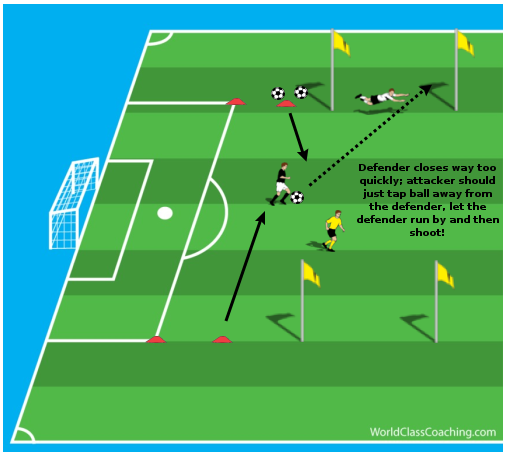
3. The Defender closes down correctly. When this occurs and the attacker is unable to take the quick shot or to use the defender’s momentum against them, the attacker needs to pull the defender outside the near post and then cut the ball back inside at a 45 degree angle setting themselves up for a shot.
[wpsharely id="2988"][/wpsharely]
- 2 v 2: Server and the player immediately in line behind them step-put to defend the receiver and the player immediately behind them; who press forward and attack the same goal as in the 1 v 1 scenario.
- 3 v 3: When progressing to these numbers only one ball should be used at a time and only one goal is attacked at a time. The goal that is attacked is still the same goal located on the end-line where the ball originated (where the ball was served from) but this time the ball alternates back-n-forth from each of the two different points of service.
- To get the 3 v 3 numbers, two players will enter from the line that serves the ball and one player will enter from the other line located on the same end line of which the ball was served. These three will be the defenders.
- The server has their choice of which of the two opposing lies they wish to serve to. The line that receives the ball will enter two players and the opposite line on that same end line will enter a third. These players will be the attackers.
- Progress to 5v5. Once you’re at 5v5, let them loose and allow them to open-up and just play a small-sided match.
By Keith Scarlett, Assistant Women's Football Coach, Perth Glory FC
http://keithscarlett.blogspot.com
Twitter - @keithscarlett

